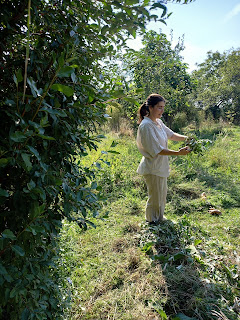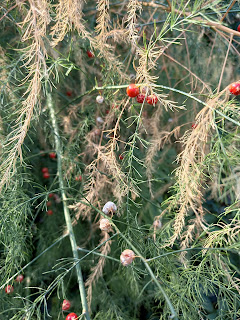We've been harvesting seeds of all shapes and sizes over the last couple of weeks. All of the plants that we collect seeds from are from the flowering plants (Angiosperms), of which there are more than a staggering 250,000 species. The majority of these plant species are found in tropical climates, and for those of us in Mediterranean, Temperate and Sub-tropical climates, there are probably around 9,000 species to cooperate with. Plenty of the seed we harvest comes from our forest garden to send to customers, sow and rear into young plants that stock the bionursery, or simply to swap and share with friends and other plant loving folk.
 |
| The dry stems and seed heads of Alliums make a pleasing contrast to the other plants |
Although we have just entered autumn and the plants in the gardens are starting to prepare to shut down for the winter, the seeds of Elaeagnus umbellata - Autumn Olive and Zanthoxylum piperitum - Japanese Pepper Tree were sown this week as it seems they can be sown as soon as the fruits are ripe. This little trick seems to bypass the winter dormancy of some species, and as long as the emerging seedlings are not subjected to sub zero temperature (better still not below 5°C) they will be fine and should be ready for pricking out into pots by March/April.
Elaeagnus umbellata - Autumn Olive
A large, nitrogen fixing deciduous shrub from east Asia, growing to 4.5 high and 4.5m wide, tolerates part shade and is very drought tolerant. Branches are often thorny, leaves are bright green and silvery beneath. Yellowish white, fragrant flowers are produced in May-June, followed by rounded silvery brown (ripening red) fruits in Sep-Oct. There are many named cultivars and plants can fruit in 5yrs from seed. We enjoy saving the seed from these plants, as the berries are very palatable. The birds also love them, so it's important to get the moment right when they are ripe enough to eat and before the birds strip them! We always leave at least 30% of the fruit on the bushes for the birds to enjoy.
Japanese Pepper Tree - Zanthoxylum piperitum
This incredible plant can be grown as a spiny shrub or a small tree, reaching dimensions of 3m by 2m. It is pretty robust, drought tolerant and copes with full sun, partial shade and even some deeper shady conditions, making it a fantastic tree for a forest garden. It's easily grown in a variety of soil types and can tolerate quite cold temperatures. Flowers are borne in June and seeds can be harvested in September - October. The plant has extensive medicinal value with all parts of the plant having a specific use. The ground and dry-roasted fruit is an ingredient of the Chinese 'five spice' powder. Harvesting the tree for seeds starts once we see the black seed emerging from some of the husks. We usually cut the whole umbel off and if all the seeds don't pop out easily just leave it to dry until the separation process becomes easier. The husks can be put into a pepper mill and used as you would black pepper, although a little more sparingly as the taste produces a clove-like numbing as well as a deliciously unique flavour.
Asparagus - Asparagus officinalis berries which are toxic to humans if eaten. We leave the berries to mature for a while but harvest them while still red, drying them on a windowsill. Watch out for the birds! I went out into the garden yesterday to collect all the berries in our home garden patch only to find the entire crop gone. The dried berries seemed to contain seed that crumbles and looks unviable.
----------------------------------------------------------------------------
Regenerative Landscape Design - Online Interactive Course
Want to learn how to design, build and manage regenerative landscapes? Join us for our Regenerative Landscape Design - Online Interactive Course from May 1st to Sep 13th, 2023.
We're super excited about running the course and look forward to providing you with the confidence, inspiration, and opportunity to design, build and manage regenerative landscapes, gardens, and farms that produce food and other resources for humans while enhancing biodiversity.

Regenerative Landscape Design Online Course
You can find out all about the course here and right now we have a 20% discount on the full enrollment fees. Just use the promo code RLD2023 in the section of the registration form to receive your discount.
We're super excited about running the course and look forward to providing you with the confidence, inspiration, and opportunity to design, build and manage regenerative landscapes, gardens, and farms that produce food and other resources for humans while enhancing biodiversity.
 |
| Regenerative Landscape Design Online Course |
You can find out all about the course here and right now we have a 20% discount on the full enrollment fees. Just use the promo code RLD2023 in the section of the registration form to receive your discount.
We are looking forward to providing you with this unique online learning experience - as far as we know, the very first of its kind. If you are thinking of reasons why you should do this course and whether this course is suitable for you, take a look here where we lay it all out. Looking forward to it!----------------------------------------------
Support Our Project
If you appreciate the work we are doing you can show your support in several ways.
- Make a purchase of plants or seeds from our Bionursery or Online Store
- Consider joining us for one of our Courses or Online Courses
- Comment, like, and share our content on social media.
- Donate directly via PayPal to balkanecologyproject@gmail.com or via FTX Pay
- Make a purchase of plants or seeds from our Bionursery or Online Store
- Consider joining us for one of our Courses or Online Courses
- Comment, like, and share our content on social media.
- Donate directly via PayPal to balkanecologyproject@gmail.com or via FTX Pay








































